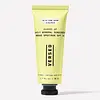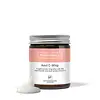What's inside
What's inside
 Key Ingredients
Key Ingredients

 Benefits
Benefits

 Concerns
Concerns

 Ingredients Side-by-side
Ingredients Side-by-side

Zinc Oxide 15.2%
Cosmetic ColorantWater
Skin ConditioningButyloctyl Salicylate
Skin ConditioningIsodecyl Neopentanoate
EmollientCalcium Sodium Borosilicate
Diheptyl Succinate
EmollientC18-21 Alkane
SolventErythritol
HumectantCetearyl Alcohol
EmollientSodium Stearoyl Glutamate
CleansingCapryloyl Glycerin/Sebacic Acid Copolymer
Skin ConditioningPropanediol
SolventArachidyl Alcohol
EmollientGlycerin
HumectantPyrus Malus Fruit Extract
Skin ConditioningCaprylic/Capric Triglyceride
MaskingTocopherol
AntioxidantCaprylyl Glycol
EmollientCoco-Glucoside
CleansingEthyl Ferulate
AntioxidantBehenyl Alcohol
EmollientCetyl Alcohol
EmollientArachidyl Glucoside
EmulsifyingBisabolol
MaskingPolyhydroxystearic Acid
EmulsifyingCitric Acid
BufferingSodium Gluconate
Skin ConditioningXanthan Gum
EmulsifyingOctyldodecyl Oleate
EmollientCaprylhydroxamic Acid
Hydrolyzed Jojoba Esters
Skin ConditioningSodium Hyaluronate
HumectantCrithmum Maritimum Extract
Skin ConditioningMaltodextrin
AbsorbentMoringa Oleifera Seed Extract
Skin ConditioningAloe Barbadensis Leaf
MaskingIron Oxides
CI 77491
Cosmetic ColorantZinc Oxide 15.2%, Water, Butyloctyl Salicylate, Isodecyl Neopentanoate, Calcium Sodium Borosilicate, Diheptyl Succinate, C18-21 Alkane, Erythritol, Cetearyl Alcohol, Sodium Stearoyl Glutamate, Capryloyl Glycerin/Sebacic Acid Copolymer, Propanediol, Arachidyl Alcohol, Glycerin, Pyrus Malus Fruit Extract, Caprylic/Capric Triglyceride, Tocopherol, Caprylyl Glycol, Coco-Glucoside, Ethyl Ferulate, Behenyl Alcohol, Cetyl Alcohol, Arachidyl Glucoside, Bisabolol, Polyhydroxystearic Acid, Citric Acid, Sodium Gluconate, Xanthan Gum, Octyldodecyl Oleate, Caprylhydroxamic Acid, Hydrolyzed Jojoba Esters, Sodium Hyaluronate, Crithmum Maritimum Extract, Maltodextrin, Moringa Oleifera Seed Extract, Aloe Barbadensis Leaf, Iron Oxides, CI 77491
Water
Skin ConditioningNiacinamide
SmoothingC15-19 Alkane
SolventCetyl Alcohol
EmollientGlyceryl Stearate Se
EmulsifyingPolyglyceryl-6 Stearate
EmollientHydroxystearic Acid
CleansingRosa Canina Seed Oil
EmollientCucurbita Pepo Seed Oil
EmollientTocopherol
AntioxidantGlycerin
HumectantSodium Anisate
AntimicrobialSodium Levulinate
Skin ConditioningSodium Ascorbyl Phosphate
AntioxidantCorn Starch Modified
AbsorbentGlyceryl Caprylate
Emollient3-O-Ethyl Ascorbic Acid
Skin ConditioningGellan Gum
Polyglyceryl-6 Behenate
Emulsion StabilisingSodium Phytate
Citrus Bergamia Peel Oil Expressed 0.226%
PerfumingWater, Niacinamide, C15-19 Alkane, Cetyl Alcohol, Glyceryl Stearate Se, Polyglyceryl-6 Stearate, Hydroxystearic Acid, Rosa Canina Seed Oil, Cucurbita Pepo Seed Oil, Tocopherol, Glycerin, Sodium Anisate, Sodium Levulinate, Sodium Ascorbyl Phosphate, Corn Starch Modified, Glyceryl Caprylate, 3-O-Ethyl Ascorbic Acid, Gellan Gum, Polyglyceryl-6 Behenate, Sodium Phytate, Citrus Bergamia Peel Oil Expressed 0.226%
 Reviews
Reviews

Ingredients Explained
These ingredients are found in both products.
Ingredients higher up in an ingredient list are typically present in a larger amount.
Cetyl Alcohol is a fatty alcohol. Fatty Alcohols are most often used as an emollient or to thicken a product.
Its main roles are:
Though it has "alcohol" in the name, it is not related to denatured alcohol or ethyl alcohol.
The FDA allows products labeled "alcohol-free" to have fatty alcohols.
Learn more about Cetyl AlcoholGlycerin is already naturally found in your skin. It helps moisturize and protect your skin.
A study from 2016 found glycerin to be more effective as a humectant than AHAs and hyaluronic acid.
As a humectant, it helps the skin stay hydrated by pulling moisture to your skin. The low molecular weight of glycerin allows it to pull moisture into the deeper layers of your skin.
Hydrated skin improves your skin barrier; Your skin barrier helps protect against irritants and bacteria.
Glycerin has also been found to have antimicrobial and antiviral properties. Due to these properties, glycerin is often used in wound and burn treatments.
In cosmetics, glycerin is usually derived from plants such as soybean or palm. However, it can also be sourced from animals, such as tallow or animal fat.
This ingredient is organic, colorless, odorless, and non-toxic.
Glycerin is the name for this ingredient in American English. British English uses Glycerol/Glycerine.
Learn more about GlycerinTocopherol (also known as Vitamin E) is a common antioxidant used to help protect the skin from free-radicals and strengthen the skin barrier. It's also fat soluble - this means our skin is great at absorbing it.
Vitamin E also helps keep your natural skin lipids healthy. Your lipid skin barrier naturally consists of lipids, ceramides, and fatty acids. Vitamin E offers extra protection for your skin’s lipid barrier, keeping your skin healthy and nourished.
Another benefit is a bit of UV protection. Vitamin E helps reduce the damage caused by UVB rays. (It should not replace your sunscreen). Combining it with Vitamin C can decrease sunburned cells and hyperpigmentation after UV exposure.
You might have noticed Vitamin E + C often paired together. This is because it is great at stabilizing Vitamin C. Using the two together helps increase the effectiveness of both ingredients.
There are often claims that Vitamin E can reduce/prevent scarring, but these claims haven't been confirmed by scientific research.
Learn more about TocopherolWater. It's the most common cosmetic ingredient of all. You'll usually see it at the top of ingredient lists, meaning that it makes up the largest part of the product.
So why is it so popular? Water most often acts as a solvent - this means that it helps dissolve other ingredients into the formulation.
You'll also recognize water as that liquid we all need to stay alive. If you see this, drink a glass of water. Stay hydrated!
Learn more about Water